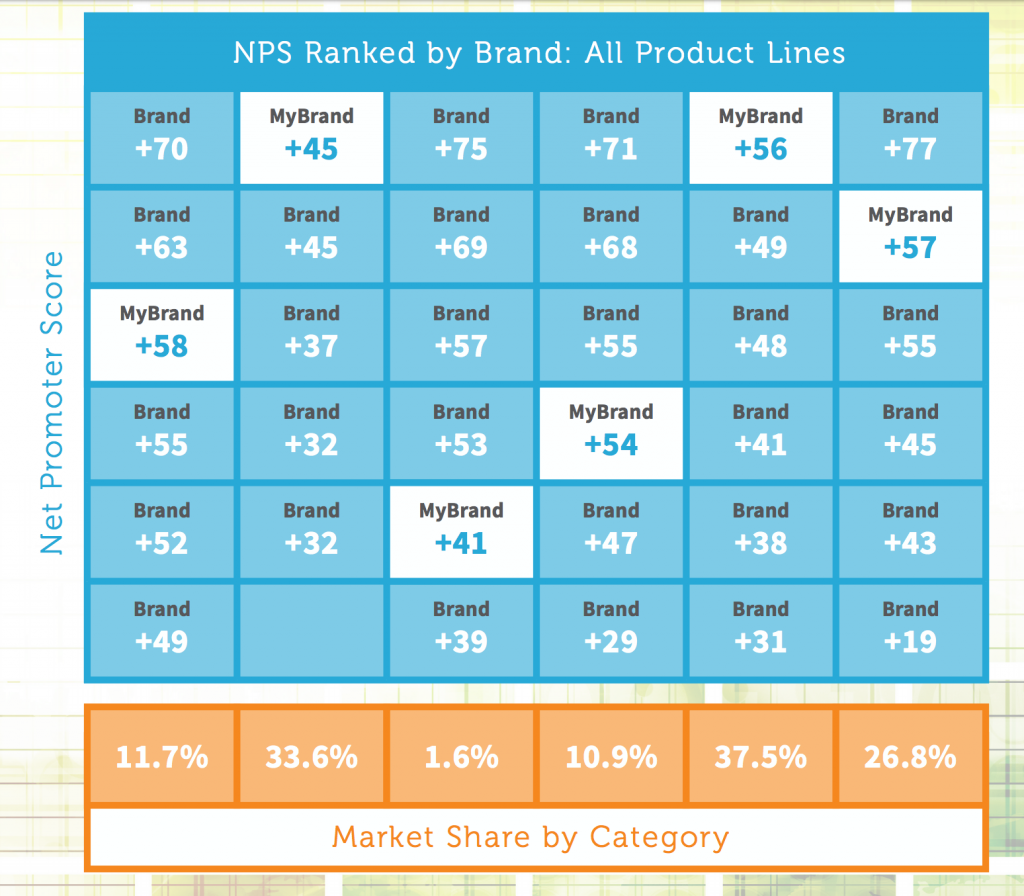The following post is part of a series that will help inform readers of the power that a company’s Net Promoter Score has on its long-term business goals.

(Source: Satmetrix. “The ROI of NPS: How to Focus on Customer Loyalty Delivers Financial Gains.” PDF. Accessed online July 18, 2017.)
Satmetrix, a CXM software company and active advocate of the power of NPS, reports that, “One of the keys to achieving financial benefits is understanding your NPS relative to competition. In this example, a consumer electronics company clearly demonstrated that the products that had the highest NPS in their category also had the highest market share, and those with lower scores, found themselves with lower market share.”
These findings make sense when you begin to break things down. Essentially, products that people are most likely to refer to friends or colleagues naturally capture the most market share, while those less frequently referred have a smaller market share. Makes logical sense, right?
Proof That NPS WORKS
It’s not just mom and pop shops that are focusing on improving their customer satisfaction rates via NPS scores. In order to more effectively reach their business goals, massive companies such as Costco, Apple, Amazon, Southwest Airlines, and Netflix have adopted NPS strategies in order to more definitively understand their customer sentiment. These reputable companies are household brand names, known for their extreme success, excellent work environments, and dominant market influence.
However, these brands don’t simply collect responses to NPS surveys and then log them away. Instead, each of them has implemented a systematic strategy that allows their entire organization to analyze the respective statistics and take meaningful action depending on their findings.
Word of Mouth is as Important as Ever
Administering NPS surveys will allow your business to establish a benchmark for customer satisfaction that you can track weekly to assess progress and standings. But remember — NPS isn’t the only customer satisfaction insight that you should be hanging your hat on.
Prior to the boom in popularity of social media, literal word of mouth marketing was king. And while social media is certainly an inescapable and massive forum for your customers to connect with you, and each other, traditional word of mouth marketing still holds significant power when it comes to how people generally feel about your products and services. With 88 percent of consumers taking stake in products and services because a friend or family member stamped their approval, word of mouth marketing is still — if not more — effective than ever.
Even if your NPS score is through the roof, you’ve got to be able to leverage the power of organic conversations that your customers are having about your product.
Triggering and managing those conversations means continuously creating extraordinarily rich experiences. If done correctly, there will be a steady stream of people that are genuinely excited to talk about your company, as well as its products and its services, because they know their friends and/or family will like it too.
This type of brand awareness and commitment from customers can be difficult to precisely measure, but it’s still the most authentic, impactful way to market products and services.
NPS and Word of Mouth Marketing
When NPS first gained immense popularity, there was finally a way to attach hard, tangible metrics to word of mouth marketing. With NPS, organizations can measure sentiment simply by asking how likely a customer would be to recommend them. A proper NPS collection methodology and analysis strategy provide companies with direct insights into their performance in the complex realm of customer conversations.
With such a high value placed on recommendations from friends and family, it’s easy to see how valuable these data points could be to all sorts of companies. Even as social media began its meteoric rise to ubiquity, everyday chats among friends offline still offer marketers an unparalleled window to the mind of the customer, their behaviors, common pain points, and other market intel.
The goal of Net Promoter Scores has always been to give companies insight into the hard to pin down metrics relevant to word of mouth marketing, and that’s been a source of both its popularity and many of its criticisms.
Some questions to consider when digging into NPS data:
- Will those who are ranked as Passives on the NPS scale tarnish a brand with faint praise?
- Are Detractors more impactful now that there are so many avenues where they can air their grievances online?
- Will Promoters really actively evangelize a product or brand?
These kinds of questions epitomize the challenges of establishing a correlation between NPS and positive word of mouth marketing, as many critics of NPS point out.
To learn more about NPS and the benefits that it can bring to your business, be sure to download our latest eBook – How to Score Big with NPS.
Does your company currently utilize NPS? Sound off in the comments below in order to be entered to win a $20 Amazon gift card.




